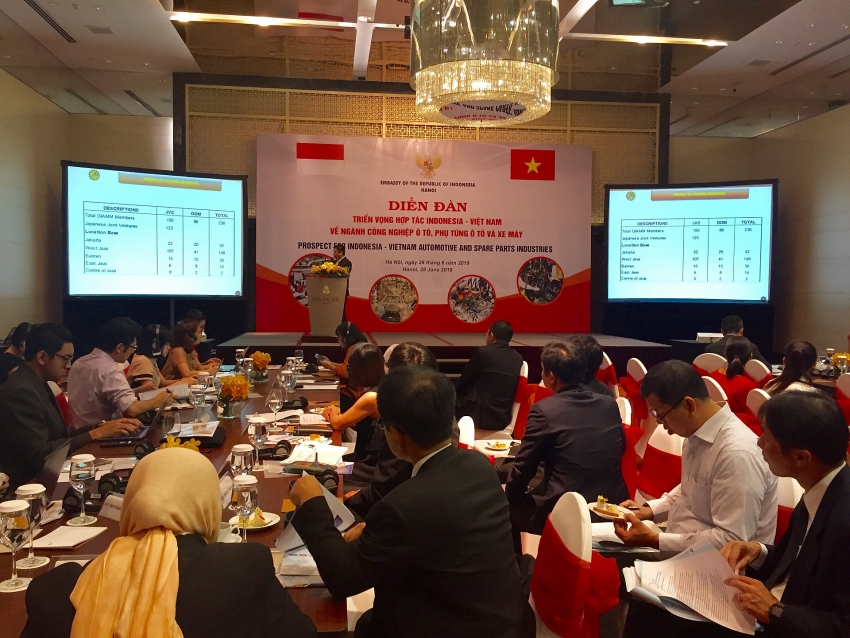Vietnam and Indonesia enhance automotive and spare parts co-operation
| |
| The forum promoting bilateral trade between Indonesia and Vietnam |
Seven Indonesian manufacturers and dozens of Vietnamese ones in the automotive and spare parts industries took part in the recent forum “Prospect for Indonesia-Vietnam automotive and spare parts industries” in Hanoi.
Opening the event, the Indonesian ambassador to Vietnam Ibnu Hadi announced that the bilateral relations between the two countries have been improving recently. In 2018, two-way trade gained $8.6 billion, up 29 per cent compared to 2017.
“One of the strongest commodities from Indonesia to Vietnam is automotive and spare parts. The main type of car imported from Indonesia to Vietnam is completely built up (CBU) under nine-seat cars. Indonesia is currently the second-largest exporter of cars to Vietnam after Thailand.” The ambassador also said that Indonesia hopes to increase car exports to Vietnam to $600 million in 2019, more than double the value last year.
Meanwhile, statistics from the Vietnam General Department of Customs showed that in 2018, Vietnam imported 17,146 cars from Indonesia, with a total turnover of $269 million. In the first five months of 2019, the number of Indonesian cars coming to Vietnam increased strongly, up to 90 per cent. Particularly in May, the number of cars imported from Indonesia to Vietnam was over 6,755 units, increasing by a whopping 84 per cent compared to April.
So far, Indonesian cars imported to Vietnam are very cheap, fetching about VND292 million ($12,695.7) per unit, the lowest among imported car groups into Vietnam.
One of the main reasons for the increasing imports of cars from Thailand and Indonesia is the impact of lower import tax rates of 0 per cent since January 1, 2018 under the ASEAN Trade in Goods Agreement (ATIGA).
Currently, cars imported from Indonesia are focusing on low-cost models like Toyota Wigo, Avanza, Rush, or Mitsubishi Xpander, competing fiercely with locally-assembled cars.
According to data from the Indonesian Automobile Manufacturers Association (Gaikindo), in the first four months of 2019, Mitsubishi Xpander was leading car exports from Indonesia, reaching 17,640 vehicles. Toyota Fortuner came second (14,478), followed by Toyota Rush (12,069), Toyota Wigo/Agya (10,179 vehicles), Toyota Avanza (8,109 cars), and Suzuki Ertiga (7,353 cars).
“Vietnam holds great potential. We know that on average, the market will need about 800-900,000 vehicles by 2025 and about 1.5-1.8 million vehicles by 2030. That is why we are here today to seek more co-operation,” Boedhi Samodhra, a representative of Gaikindo told VIR.
According to Boedhi, as the two members of the ASEAN, Vietnam and Indonesia both get profit from the ATIGA, if automotive enterprises from the two countries co-operate with each other, that will be a win-win relation, particularly in the context of the Vietnam-EU Free Trade Agreement that will soon come into effect in Vietnam.
What the stars mean:
★ Poor ★ ★ Promising ★★★ Good ★★★★ Very good ★★★★★ Exceptional
Related Contents
Latest News
More News
- PM sets January deadline for high-speed rail consultant (January 06, 2026 | 08:40)
- New decree spurs on PPP implementation (December 31, 2025 | 19:01)
- Global alliance develops $1 billion AI data centre network in Vietnam (December 30, 2025 | 10:08)
- Standing out in the Chinese outbound investment wave (December 29, 2025 | 10:29)
- Bright spots obvious in foreign investment mission (December 29, 2025 | 09:00)
- Ho Chi Minh City hits $8.37 billion in FDI (December 29, 2025 | 08:28)
- Vietnam and UK cooperation backs finance talent for IFCs (December 27, 2025 | 16:31)
- Global partnerships key to Vietnam’s IFC development (December 26, 2025 | 16:18)
- Vingroup pulls out of bid to invest in North-South high-speed railway (December 26, 2025 | 11:42)
- Strengthening supply chains through trade promotions and customs reform (December 24, 2025 | 14:00)


 Tag:
Tag:
























 Mobile Version
Mobile Version